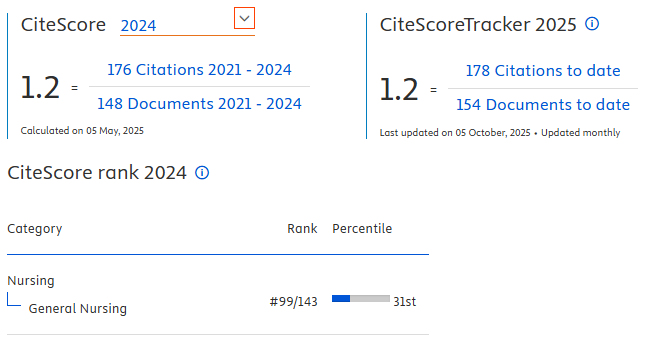A Systematic Review of the Factors Associated with Cervical Cancer Screening Uptake among Women in Low and Middle-Income Countries
Downloads
Introduction: This review aims to explore the factors influencing cervical screening uptake among women in low and middle-income countries.
Methods: The studies were systematically identified by searching electronic databases with the keywords "cervical cancer AND screening AND low of income countries AND middle of income countries.” The results consisted of 94 articles from Scopus, 100 articles from Science Direct, 74 articles from EBSCO, and 32 articles from PubMed. Following this, 16 studies were included in this systematic review with the inclusion criteria being quantitative or qualitative studies exploring the factors influencing woman's cervical cancer screening uptake covering women in low- and middle- income countries, a clear study outcome and details on the associated factors, barriers to, and facilitators of screening uptake.
Results: Knowledge about the disease and its prevention, knowing someone with cervical cancer and someone who has ever been screened, attitude and perception, husband approval, advice from the health care providers, and the distance to health care service were all important factors related to cervical cancer screening uptake in low and middle-income countries. The uptake of cervical cancer screening services was poor in low and middle-income countries. There is a need to strengthen the knowledge and awareness of woman related to cervical cancer screening services.
Conclusion: The available evidence shows that intrapersonal and organizational factors are the most important factors that influence woman to undergo cervical cancer screening.
Anwar, S. L., Tampubolon, G., Van Hemelrijck, M., Hutajulu, S. H., Watkins, J., & Wulaningsih, W. (2018). Determinants of cancer screening awareness and participation among Indonesian women. BMC Cancer, 18(1), 1–11. https://doi.org/10.1186/s12885-018-4125-z
Bray, F., Ferlay, J., Soerjomataram, I., Siegel, R. L., Torre, L. A., & Jemal, A. (2018). Global cancer statistics 2018: GLOBOCAN estimates of incidence and mortality worldwide for 36 cancers in 185 countries. CA: A Cancer Journal for Clinicians, 68(6), 394–424. https://doi.org/10.3322/caac.21492
Chan, D. N. S., & So, W. K. W. (2017). A Systematic Review of the Factors Influencing Ethnic Minority Women's Cervical Cancer Screening Behavior: From Intrapersonal to Policy Level. Cancer Nursing, 40(6), E1–E30. https://doi.org/10.1097/NCC.0000000000000436
Donatus, L., Nina, F. K., Sama, D. J., Nkfusai, C. N., Bede, F., Shirinde, J., & Cumber, S. N. (2019). Assessing the uptake of cervical cancer screening among women aged 25-65 years in Kumbo West Health District, Cameroon. Pan African Medical Journal, 33, 1–11. https://doi.org/10.11604/pamj.2019.33.106.16975
Farzaneh, E., Heydari, H., Shekarchi, A. A., & Kamran, A. (2017). Breast and cervical cancer-screening uptake among females in Ardabil, northwest Iran: A community-based study. OncoTargets and Therapy, 10, 985–992. https://doi.org/10.2147/OTT.S125344
Idowu, A., Olowookere, S. A., Fagbemi, A. T., & Ogunlaja, O. A. (2016). Determinants of Cervical Cancer Screening Uptake among Women in Ilorin, North Central Nigeria: A Community-Based Study. Journal of Cancer Epidemiology, 2016(Vili). https://doi.org/10.1155/2016/6469240
Islam, R. M., Billah, B., Hossain, M. N., & Oldroyd, J. (2017). Barriers to cervical cancer and breast cancer screening uptake in low-income and middle-income countries: A systematic review. Asian Pacific Journal of Cancer Prevention, 18(7), 1751–1763. https://doi.org/10.22034/APJCP.2017.18.7.1751
Liebermann, E. J., VanDevanter, N., Hammer, M. J., & Fu, M. R. (2018). Social and Cultural Barriers to Women's Participation in Pap Smear Screening Programs in Low- and Middle-Income Latin American and Caribbean Countries: An Integrative Review. Journal of Transcultural Nursing, 29(6), 591–602. https://doi.org/10.1177/1043659618755424
Lyimo, F. S., & Beran, T. N. (2012). Demographic, knowledge, attitudinal, and accessibility factors associated with uptake of cervical cancer screening among women in a rural district of Tanzania: Three public policy implications. BMC Public Health, 12(1), 1–8. https://doi.org/10.1186/1471-2458-12-22
Ncube, B., Bey, A., Knight, J., Bessler, P., & Jolly, P. E. (2015). Factors associated with the uptake of cervical cancer screening among women in Portland, Jamaica. North American Journal of Medical Sciences, 7(3), 104–113. https://doi.org/10.4103/1947-2714.153922
Ndejjo, R., Mukama, T., Kiguli, J., & Musoke, D. (2017). Knowledge, facilitators and barriers to cervical cancer screening among women in Uganda: A qualitative study. BMJ Open, 7(6), 1–8. https://doi.org/10.1136/bmjopen-2017-016282
Ndejjo, R., Mukama, T., Musabyimana, A., & Musoke, D. (2016). Uptake of cervical cancer screening and associated factors among women in rural Uganda: A cross sectional study. PLoS ONE, 11(2), 1–13. https://doi.org/10.1371/journal.pone.0149696
Ndikom, C. M., & Ofi, B. A. (2012). Awareness, perception and factors affecting utilization of cervical cancer screening services among women in Ibadan, Nigeria: A qualitative study. Reproductive Health, 9(1), 1–8. https://doi.org/10.1186/1742-4755-9-11
Nigussie, T., Admassu, B., & Nigussie, A. (2019). Cervical cancer screening service utilization and associated factors among age-eligible women in Jimma town using health belief model, South West Ethiopia. BMC Women's Health, 19(1), 1–10. https://doi.org/10.1186/s12905-019-0826-y
Okunowo, A. A., Daramola, E. S., Soibi-Harry, A. P., Ezenwankwo, F. C., Kuku, J. O., Okunade, K. S., & Anorlu, R. I. (2018). Women's knowledge of cervical cancer and uptake of Pap smear testing and the factors influencing it in a Nigerian tertiary hospital. Journal of Cancer Research and Practice, 5(3), 105–111. https://doi.org/10.1016/j.jcrpr.2018.02.001
Orang'O, E. O., Wachira, J., Asirwa, F. C., Busakhala, N., Naanyu, V., Kisuya, J., ... Inui, T. (2016). Factors associated with uptake of visual inspection with acetic acid (VIA) for cervical cancer screening in western Kenya. PLoS ONE, 11(6), 1–12. https://doi.org/10.1371/journal.pone.0157217
Owen, N., Heart, B., & Fisher, E. B. (2008). AND HEALTH.
Pyatak, E. A., Carandang, K., Vigen, C. L. P., Blanchard, J., Diaz, J., Concha-Chavez, A., ... Peters, A. L. (2018). Occupational therapy intervention improves glycemic control and quality of life among young adults with diabetes: The resilient, empowered, active living with diabetes (REAL Diabetes) randomized controlled trial. Diabetes Care, 41(4), 696–704. https://doi.org/10.2337/dc17-1634
Rahmawati, N. A., & Dewanti, L. (2018). Direct experience with cervical cancer patient, husband support, and self-perception as determinant factors of women's desire to take VIA screening test. Kesmas, 13(1), 36–42. https://doi.org/10.21109/kesmas.v13i1.1617
Rohan, J. M., Huang, B., Pendley, J. S., Delamater, A., Dolan, L., Reeves, G., & Drotar, D. (2015). Predicting health resilience in pediatric type 1 diabetes: A test of the resilience model framework. Journal of Pediatric Psychology, 40(9), 956–967. https://doi.org/10.1093/jpepsy/jsv061
Schliemann, D., Su, T. T., Paramasivam, D., Treanor, C., Dahlui, M., Loh, S. Y., & Donnelly, M. (2019). Effectiveness of Mass and Small Media Campaigns to Improve Cancer Awareness and Screening Rates in Asia: A Systematic Review. Journal of Global Oncology, (5), 1–20. https://doi.org/10.1200/jgo.19.00011
Steinhardt, M. A., Brown, S. A., Dubois, S. K., Harrison, L., Matthew Lehrer, H., & Jaggars, S. S. (2015). A resilience intervention in African-American adults with type 2 diabetes. American Journal of Health Behavior, 39(4), 507–518. https://doi.org/10.5993/AJHB.39.4.7
Teame, H., Gebremariam, L., Kahsay, T., Berhe, K., Gebreheat, G., & Gebremariam, G. (2019). Factors affecting utilization of cervical cancer screening services among women attending public hospitals in Tigray region, Ethiopia, 2018; Case control study. PLoS ONE, 14(3), 1–11. https://doi.org/10.1371/journal.pone.0213546
Tiruneh, F. N., Chuang, K. Y., Ntenda, P. A. M., & Chuang, Y. C. (2017). Individual-level and community-level determinants of cervical cancer screening among Kenyan women: A multilevel analysis of a Nationwide survey. BMC Women's Health, 17(1), 1–14. https://doi.org/10.1186/s12905-017-0469-9
Touch, S., & Oh, J. K. (2018). Knowledge, attitudes, and practices toward cervical cancer prevention among women in Kampong Speu Province, Cambodia. BMC Cancer, 18(1), 1–8. https://doi.org/10.1186/s12885-018-4198-8
Weng, Q., Jiang, J., Haji, F. M., Nondo, L. H., & Zhou, H. (2020). Women's knowledge of and attitudes toward cervical cancer and cervical cancer screening in Zanzibar, Tanzania: A cross-sectional study. BMC Cancer, 20(1), 1–12. https://doi.org/10.1186/s12885-020-6528-x
Authors who publish with Jurnal Ners agree to the following terms:
- Authors transfer the Copyright and grant Jurnal Ners the right of first publication with the work simultaneously licensed under a Creative Commons Attribution 4.0 International License that allows others to remix, adapt and build upon the work with an acknowledgment of the work's authorship and of the initial publication in Jurnal Ners.
- Authors are permitted to copy and redistribute the journal's published version of the work (e.g., post it to an institutional repository or publish it in a book), with an acknowledgment of its initial publication in Jurnal Ners.
Jurnal Ners requires a formal written declaration and transfer of copyright from the author(s) for each article published. We, therefore, ask you to complete and return this form, retaining a copy for your own records. Your cooperation is essential and appreciated. Any delay will result in a delay in publication. The form can be downloaded HERE.
































